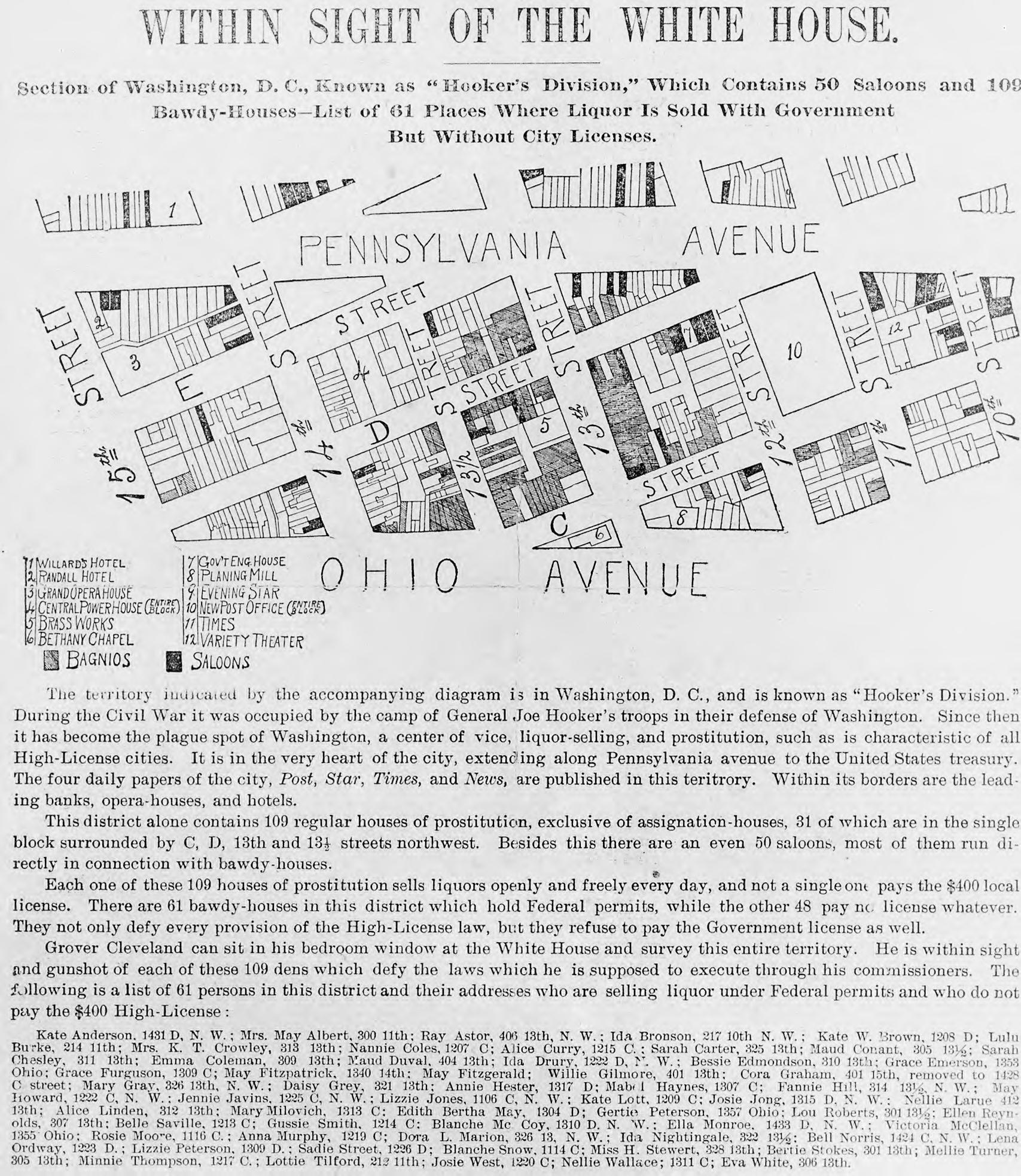Disir
Platinum Member
- Sep 30, 2011
- 28,003
- 9,607
- 910

Within sight of the White House : section of Washington, D.C., known as "Hooker's Division," which contains 50 saloons and 109 bawdy-houses--list of 61 places where liquor is sold with government [sic] but without city licenses.
Murder Bay was a dumpy, slummy, and most notably, terribly dangerous neighborhood just east of the White House. Within the confines of Murder Bay — now occupied by the massive buildings of Federal Triangle — was Hooker’s Division, or “The Division,” in which there were close to 100 houses of prostitution.
The Division gained its name from Brigadier General Joseph Hooker. Camped with his troops outside of Washington during the Civil War, the mischievous shenanigans of his soldiers during off-duty hours frustrated Hooker and, in trying to curb irresponsible behavior, he forced all the lascivious behavior into a centralized spot in Murder Bay. While not solving the problem, he at least aided the military police in localizing and containing the behavior into a manageable neighborhood of vice (manageable is used very loosely here).
Rough-and-Tumble Lost Neighborhood of Murder Bay - Ghosts of DC
But, before it was referred to as Hooker's Division it was already notorious.
The first substantial dwelling in Reservation C was a large, three-story, brick dwelling erected in Lot 12 by Mary Ann Hall. ³ According to census records, Hall was a single woman who was in her early twenties at the time she built this large dwelling. The 1840 census indicated that she lived in the house with four other women who were also in their twenties, a free black woman in her late twenties or early thirties, and a black male between the ages of 10 and 24 who was a slave. ⁴
Mary Ann Hall built her brothel in a convenient location near the U.S. Capitol Building in a city known for its large population of transient men who came from all over the country, usually unaccompanied by women, to transact business in the national capital. ⁵ Tax records show that Mary Hall prospered during her first decade in business, the value of her property doubling between 1840 and 1850 and her personal property increasing by more than thirty percent.⁶
Although little published information survives about Mary Ann Hall's brothel or about prostitution in general in nineteenth-century Washington, Hall probably operated her establishment in a manner similar to the high-class "parlor houses" common in New York City at the time. The typical parlor house served men of wealth and distinction in a discreet and elegant environment, each transaction beginning with a shared bottle of champagne provided, at an exorbitant price, by the house. The prostitutes who worked in these houses were noted for their youth, beauty, and social refinement. ⁷ In a rare nineteenth-century publication entitled Mysteries and Miseries of America's Great Cities, a full chapter is devoted to illicit activities in Washington, D.C. In the book, the author implies that the nature of Washington as the national capital offered high-class prostitutes additional business opportunities, because they could be hired to use their charms to influence the passage of particular laws on the floors of Congress. If they succeeded, they were rewarded handsomely by the corporate interests who derived benefits from the legislation (Figure 3). ⁸
...Mary Ann Hall's obituary in the Evening Star read "Departed this life, 2 am Friday January 29, 1886, Mary A. Hall, long a resident of Washington. With integrity unquestioned a heart ever open to appeals of distress, a charity that was boundless, she is gone; but her memory will be kept green by many who knew her sterling worth." She had a "strictly private funeral" and was buried in Congressional Cemetery." ³⁵ Her grave, which remains in the cemetery, is marked by a large and dignified marble gravestone that features a female figure mourning over an urn. The adjacent gravestone in the large family plot commemorates her mother and a sister, who both died in the 1860s.
A month after Mary Ann Hall's funeral, her brothers, two working-class men with families, attempted to wrest from her surviving sisters, two successful prostitutes, their share of her sizable estate. The papers generated by the dispute, all filed at the District of Columbia Archives, show that in her 71 years of life, Hall accumulated real estate worth more than $20,000, bonds and securities worth about $67,000, and no debts.
Archaeological Investigations | Archaeological Investigations | Architectural History & Historic Preservation (AHHP) |Smithsonian
One of the colorful characters of DC. that is buried in the Congressional Cemetery.
Last edited:
